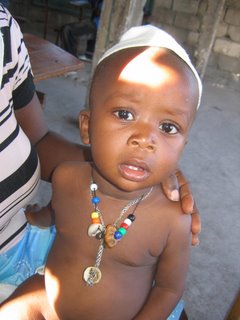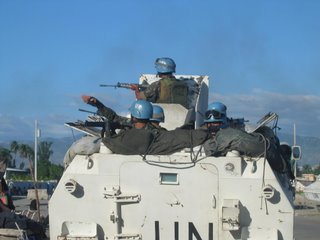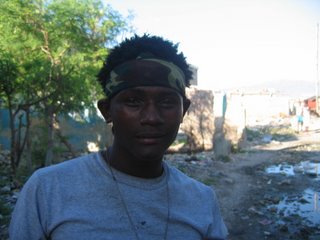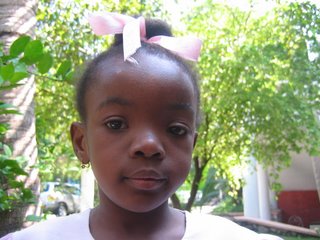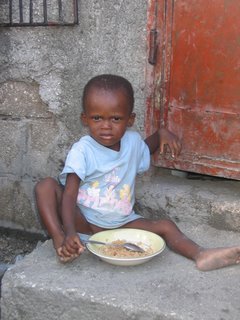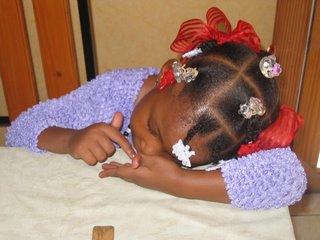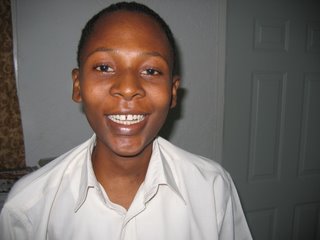
The following is an account of two trips with a mobile medical team in Port-au-Prince. I can’t mention the names of anyone, because, as the Haitians say, things are “hot” in Haiti.
Father and his mobile medical team picked me up in the morning. The plan was to work in two slums in Port-au-Prince. There were about six Haitian guys on his medical team in the vehicle. Father told me that he needed to pick up the body of an old man that died and give it a proper burial before we headed for the slum and the clinics. Another missionary had notified Father of his death the day before.
Our driver drove us down to airport road and we headed across Route National 1. The cemetery was on one corner and UN tanks on the other. We headed a few feet down the Route National 1 and then took a hard left down a dirt road for two miles. I hadn’t been on this road for over one year. There was no traffic due to the kidnappings and carjackings over the last several years. The soccer fields were empty.
At the end of the dirt road we turned right onto notorious Route 9 which leads directly out of the slum. We headed north into the countryside for several miles.
The sugar cane fields looked really healthy to the east. Passing over a bridge revealed ladies down on the edge of the little brown river washing their clothes.
The missionary bringing the body was not at the second bridge as was planned and so Father called him with his cell phone. He said he was just several minutes away. A small crowd of people stopped on the edge of the road to see what we were doing. A man selling popcorn wrapped in cellophane bags came along and sold us about 10 bags that everyone seemed to dive into like we were at a movie.
Father proudly showed us his cardboard coffin he had made for the newly deceased man. It was in the shape of a coffin and looked quite impressive as we laid it on the highway behind our truck. Father remarked how the coffins in the future will have a coat of brown varnish on them as well as a symbol of his order. As we munched the popcorn, we all stared approvingly at the coffin.
Father takes the dead quite seriously in Haiti and he does all he can to give them a proper burial. He believes this is the highest form of charity. Father receives calls like this all of the time and has purchased some spots in the cemetery that we passed to bury the remains. If he did not, the families of the deceased have no money for a proper burial, and the bodies go from a general morgue to a field where pigs eat them and they rot in the sun.
As promised, a white van came from the north with a white man driving. A Haitian man was in the front passenger seat. The white man had a nice peaceful smile as he opened the back of the van. Lying on a green Styrofoam cushion was the body that needed a proper burial. It was covered with a white sheet. The deceased’s left elbow was sticking out just a little.
The popcorn was put down, and we carefully lowered the body into the cardboard coffin and slipped the lid back on. Father said about 5 minutes of prayer in Creole including the Our Father and a song as we stared down at the coffin on the highway. Everything was done with respect as the people on the side of the road watched. We then lifted the coffin into the back of our truck, some guys climbed in beside it, and the rest sat up front in the two cabs. We turned around in the middle of the road and went zooming back into Port-au-Prince.
Upon arriving back at the cemetery in the city, the graveyard man seemed happy to see us. He looked like he was about 80 years old, had a very distinguished face, with a full head of gray, straight hair.
We scooted the coffin out of the medical van and carried it to a vault that had the side panel removed by two men. Peering down into the hole that would be the body’s resting place forever revealed a drop off of several feet. Another couple of prayers were said by Father and we slid the casket down into the dark hole and it landed with a clunk.
We walked several yards away where there is a “Baron’s Cross” to honor Baron Samdi who is chief of the Gede Spirits. These spirits are responsible for the dead, cemeteries, and procreation. Believers honor the Gede as well as their dead relatives in the cemetery.
At the foot of Baron’s cross, which was made out of stone, were burned human bones. I could identify femurs and humerii. A small empty bottle of rum was on the ground and a Haitian coin and two Gillette razors were carefully placed on one of the arms of the Baron’s cross.
After leaving the cemetery, we piled back into the mobile medical van, passed some white UN tanks, and headed for La Saline. We stopped once on the way and purchased some small bags of water to have clean water to mix with the powdered antibiotics for the babies.
La Saline is another slum on the ocean front. There are four main slums in Port-au-Prince with an 8 square mile area. These slums are homes to hundreds of thousands of unfortunate people.
I have been coming to Haiti for 25 years and La Saline was the worst area I have seen. I won’t try and describe the garbage, sewage, heat, people, and traffic as we inched our way through the slum. No written words do it real justice.
We headed to Waf Jeremy (Jeremy’s Wharf), a pathetic zone inside of Saline. It sits right on the brown colored Port-au-Prince Bay which flows in from the Caribbean. Because we couldn’t move in the traffic, we got out and carried the picnic sized coolers filled with medication to the shanty Father uses as a clinic. The streets were black puddles and mud with pigs, people, and men pulling incredible loads on carts.
Upon arriving in the clinic, which had a dirt floor and corrugated metal walls, we found a 12 year old girl lying on an old green army cot surrounded by many of the patients. She had an IV hung with solution dripping in. Father said a quick prayer for her and for a successful clinic day and we started. I walked around the clinic and picked out the five sickest adults and babies and they were drug and carried out to Father’s vehicle where they were transported to another clinic in the city where they could be admitted and given “more comprehensive care”. Two adults acted confused as if they had typhoid fever from the fetid water in La Saline.
I was assigned an “office” in the corner. It had a chair and a small table for me to write. The patients chair legs were stuck in the hard black mud and was not moveable. Adults and children would file in over the morning with hernias, abscesses, hypertension, heart failure, and malnutrition.
The clinic pharmacy was set up a few feet away from me where we could treat some of the basic tropical diseases that we encountered. We also had a point-of-care lab tests which included HIV. Patients were given rendez-vous for the following week depending on their illness and need for follow up.
Behind the steel wall a few feet away was a classroom which shared the same wall as our clinic. Children that were neatly dressed in red and white uniforms and appeared to be kindergarten were in the classroom. There were no chalkboards, books, pencils,
papers, crayons, or anything academic that I could see. The teacher sat at the door talking on her cell phone.
When clinic was almost over, I heard gunshots in the distance. It was hard to tell exactly where they originated. Our vehicle came back for us and we walked about a one quarter mile through the narrow paths by women doing their laundry in large plastic bowels in the mud and kids in uniform leaving school for the day. People in the neighborhood waved good by to us. Some of our patients were walking with us. They were glad to be getting home because of the gunshots.
We left for Cite Soleil for our second clinic. Turning off of the main street into Soleil revealed four UN tanks with blue helmets seen barely poking out of the top. Two Jordanian UN troops were killed several weeks ago in a skirmish with one of the gangs in Soleil.
The roads in Soleil were cleaner than in La Saline but some were completely blocked with large rocks to keep the UN forces out. Clinic was held in a two story house made of cinderblock. There was no electricity and no running water. The ground floor was packed dirt. The upstairs floor was cement. It was nice and cool in the building—there were no windows and a breeze came through large spaces in the cinderblock. I checked pediatric patients downstairs and adults upstairs.
The Soleil children are usually accompanied by their mother and most were babies. I worked in a room that was dark and so I sat by the door to get as much light as I could to examine them and write a brief medical note.
The babies and children were malnourished and many had fever. They were very docile and made little eye contact. The mothers were appreciative of anything we attempted to do for their children. They picked up their children’s medication in a room near the front door.
Upstairs the adults had the same complaints as most poor Haitians. However, some were just very stressed living in Soleil with the constant warfare between the gangs and the UN forces. The cinderblock wall behind my table had four bullet holes from the UN’s powerful weapons.
After we had been working about an hour, a local gang leader with dreadlocks ascended the steps with his machine gun slung over his shoulder. He was just seeing how things were going and quietly talked with Father for awhile and left.
Clinic mercifully ended about 3:30 PM and we packed and left. However, Father had been sent a message that another more important gang leader wanted to see him before we left Soleil.
We stopped in his neighborhood and Father visited him for about 40 minutes. The gang leader there is considered the most vicious of the five leaders in Cite Soleil. He had a big smile but his eyes were very cold. Murals were painted on the wall of the Sacred Heart of Jesus and another wall had a brightly painted machine gun. A Che Guervera flag flew in the breeze over the cement compound. Young men walked close by with their 45’s in their right front pocket. If I hadn’t seen the guns, it just looked like a cleaner neighborhood in Soleil. After the meeting was over, we left for home.
Father has a good relationship with all of the gang leaders which has allowed him to negotiate for the release of 60 people ransomed and held in Cite Soleil during the last year.
The kidnapping in Haiti is higher than any other country in the western hemisphere. Port-au-Prince is particularly dangerous. People are taken in the street, many in the middle of the day, and delivered to a particular gang in the slum. Calls are made to the captive’s family and prices discussed. With Father’s influence, the ransom is brought to another gang leader and the taken person is hopefully safely transferred as is the money. The kidnapping gang trust the other gang leaders and hope they will avoid a sting by having the other gang involved. The ransom money is used to buy more bullets and rum.


